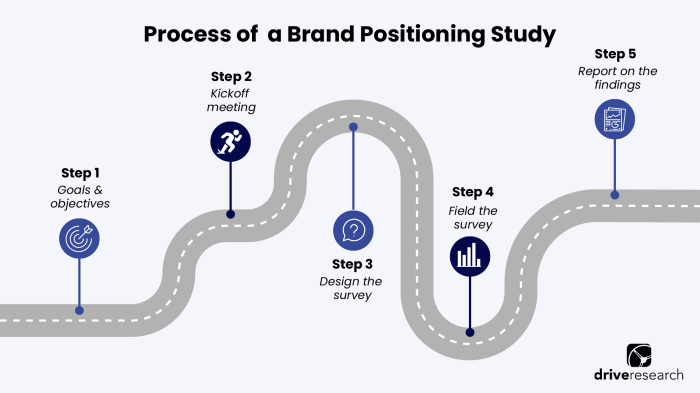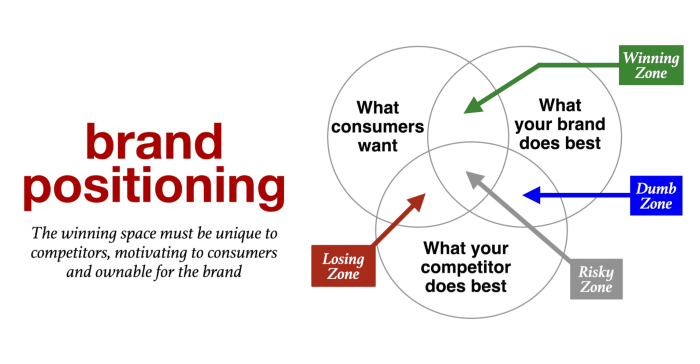Understanding Brand Positioning dives deep into the art of creating a distinct identity in the market, setting the stage for brands to shine brightly amidst competition. From defining the concept to exploring effective strategies, this topic is a must-read for marketers looking to elevate their brand game.
Definition of Brand Positioning

Brand positioning is how a company differentiates itself in the minds of its target consumers compared to its competitors. It involves creating a unique and desirable image for a brand in order to establish a strong presence in the market.
Examples of Well-Known Brands with Strong Positioning Strategies, Understanding Brand Positioning
- Apple: Known for innovation, sleek design, and user-friendly technology.
- Nike: Positioned as a brand for athletes and individuals striving for excellence.
- Coca-Cola: Emphasizes happiness, togetherness, and refreshing experiences.
How Brand Positioning Influences Consumer Perception
Brand positioning directly impacts how consumers perceive a brand and its products. By effectively positioning a brand, companies can create a positive image, build trust, and establish loyalty among consumers. This perception can influence purchasing decisions, brand advocacy, and overall success in the market.
Elements of Brand Positioning: Understanding Brand Positioning

Effective brand positioning relies on several key elements that work together to create a unique and compelling brand identity. These elements include brand values, messaging, target audience, and competitor analysis.
Brand Values
Brand values are the core beliefs and principles that a brand stands for. They guide the decisions and actions of the brand and help shape its identity. Consistency in upholding these values is crucial for building trust and loyalty among consumers.
- Brand values should align with the brand’s mission and vision.
- They should be communicated clearly and consistently through all brand touchpoints.
- Brand values help differentiate the brand from competitors and attract like-minded customers.
Messaging
Messaging refers to the language and tone used by a brand to communicate with its audience. It includes taglines, slogans, and overall brand voice. Effective messaging should resonate with the target audience and convey the brand’s values and benefits.
- Consistent messaging helps reinforce the brand’s positioning in the minds of consumers.
- It should be tailored to the preferences and interests of the target audience.
- Messaging should be clear, concise, and memorable to make a lasting impression.
Target Audience
Understanding the target audience is essential for successful brand positioning. Brands need to identify their ideal customers, their needs, preferences, and behaviors to create tailored marketing strategies that resonate with them.
- Target audience analysis helps brands create relevant and engaging content.
- It allows brands to address specific pain points and offer solutions that meet consumer demands.
- By knowing their target audience, brands can position themselves as the go-to choice for their customers.
Competitor Analysis
Analyzing competitors is crucial for developing a unique brand position in the market. By understanding what competitors are doing well and where they fall short, brands can identify opportunities for differentiation and innovation.
- Competitor analysis helps brands identify gaps in the market that they can fill.
- It allows brands to capitalize on their strengths and mitigate weaknesses compared to competitors.
- By staying informed about competitors’ strategies, brands can adapt and evolve their positioning to stay ahead in the market.
Strategies for Effective Brand Positioning
In order to establish a strong brand position, companies can utilize a variety of strategies that help differentiate their brand from competitors and ensure relevance to target audiences.
Differentiation and Relevance
Differentiation and relevance are two key elements in brand positioning that can make a brand stand out in the market. Differentiation involves highlighting unique features or benefits that set a brand apart from competitors, while relevance ensures that the brand’s positioning resonates with the needs and preferences of its target audience. By effectively combining these two elements, brands can create a compelling position that captures the attention of consumers.
- Creating a Unique Value Proposition: Brands can differentiate themselves by developing a unique value proposition that clearly communicates the benefits of their products or services. This helps consumers understand what sets the brand apart and why they should choose it over competitors.
- Consistent Brand Messaging: Consistency in brand messaging across all touchpoints is essential for establishing a strong brand position. By ensuring that all communications reflect the brand’s differentiation and relevance, companies can build trust and loyalty with customers.
- Targeted Marketing Campaigns: Brands can tailor their marketing campaigns to specific segments of their target audience, addressing their unique needs and preferences. This personalized approach helps establish relevance and strengthens the brand’s position in the minds of consumers.
Successful Brand Positioning Strategies in Various Industries
Successful brand positioning strategies can be observed in various industries, where companies have effectively differentiated themselves and remained relevant to their target markets.
- Apple: Apple has successfully positioned itself as a premium technology brand known for innovation and sleek design. By focusing on product differentiation and creating a strong emotional connection with consumers, Apple has built a loyal customer base.
- Nike: Nike’s brand positioning revolves around the idea of empowering athletes and promoting a “just do it” attitude. By emphasizing performance, innovation, and inspiration, Nike has become a leading sports brand globally.
- Coca-Cola: Coca-Cola has positioned itself as a timeless and iconic brand associated with happiness and refreshment. Through consistent branding and marketing efforts, Coca-Cola has maintained its relevance across generations.
Communicating Brand Positioning
In order to effectively communicate brand positioning to the target audience, brands must utilize various branding elements and maintain consistency in messaging. This ensures that the intended brand image and message are conveyed clearly and effectively.
Role of Branding Elements
Branding elements such as logos, taglines, and visual identity play a crucial role in conveying brand positioning to the target audience. These elements serve as visual cues that help consumers identify and differentiate the brand from its competitors. Logos, for example, are often the first thing that comes to mind when people think of a brand, making them a powerful tool for communicating brand values and positioning.
Taglines also play a key role in succinctly summarizing what the brand stands for, while visual identity elements such as color schemes, typography, and imagery help create a cohesive and memorable brand image.
Consistency in Messaging
Consistency in messaging and branding is essential for reinforcing brand position in the minds of consumers. By consistently communicating key brand messages and values through various marketing channels, brands can build brand recognition and loyalty among their target audience. Consistent branding also helps create a strong brand identity that consumers can easily associate with the brand, leading to increased brand recall and preference.
Overall, maintaining consistency in messaging and branding is crucial for effectively communicating brand positioning and building a strong brand presence in the market.
